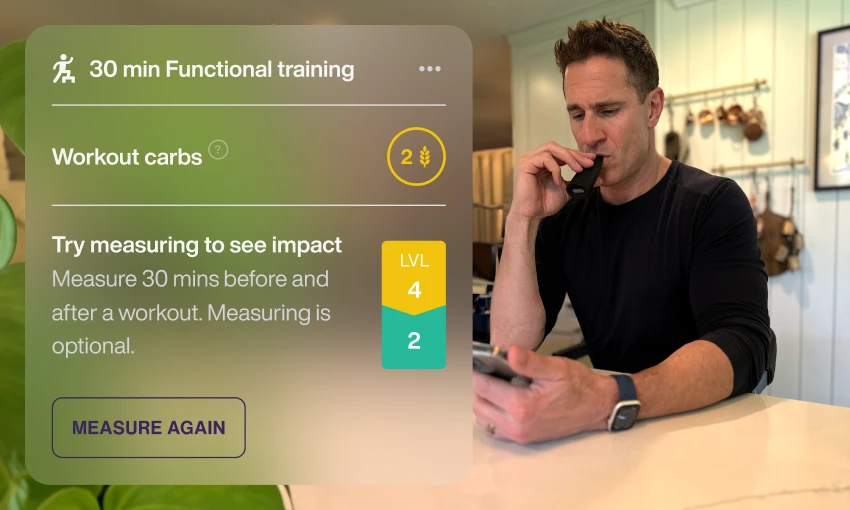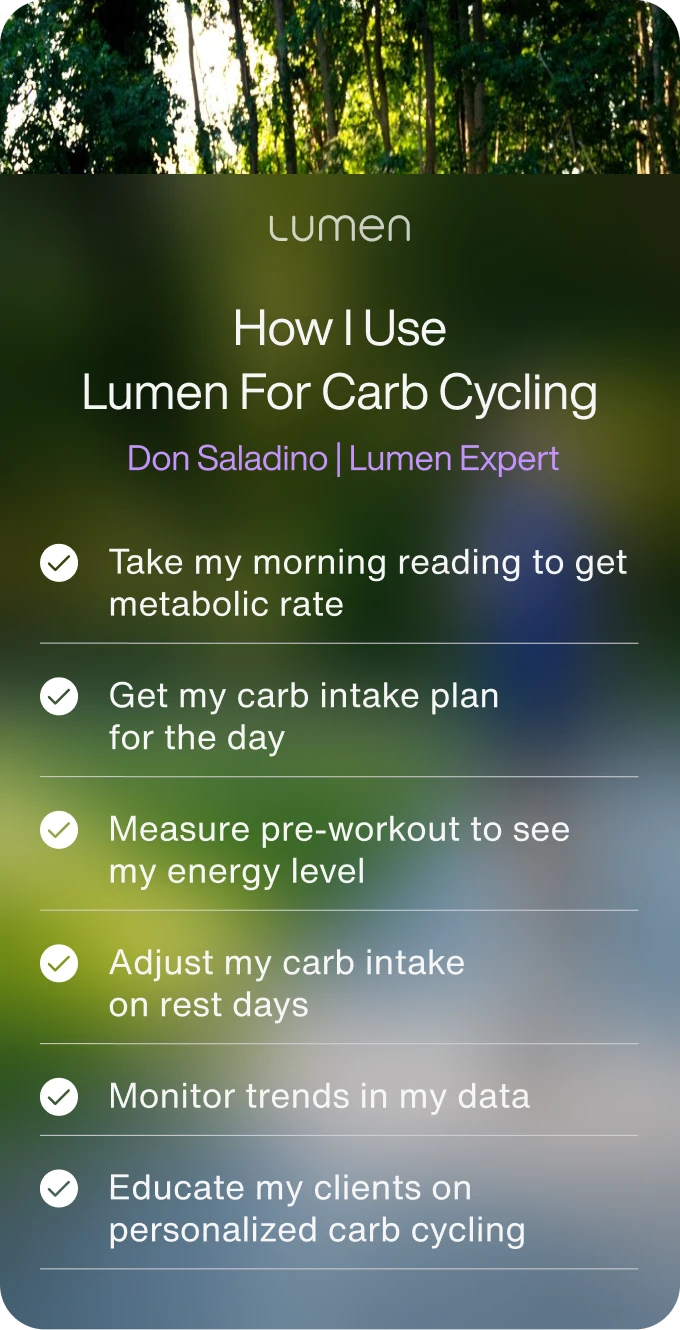Carb cycling for body recomposition: Don Saladino weighs in


Metabolic health and exercise are intimately connected. Regular physical activity can contribute to metabolic health by boosting insulin sensitivity, increasing energy expenditure, and promoting weight loss.
Getting adequate physical activity can help reduce the risk of several chronic diseases, improve insulin sensitivity, build lean muscle, increase energy, promote weight loss, and generally improve metabolic function in many ways.
But is there a certain amount of carb intake that can help maximize the health benefits of exercise?
Everyone’s body is different.
What is “optimal” for one person may be too much or too little for another person.
We spoke with Don Saladino, celebrity fitness trainer, on how your carb intake around a carb cycling meal plan for fat loss and exercise plays a pivotal role in metabolic health. We also look into the metabolic biofeedback you can get to make optimal decisions for your body and health goals.
Carb cycling isn't a new concept; in fact, many bodybuilders and athletes have been leveraging it for decades. The idea is pretty straightforward: you alternate between days of high carbohydrate intake and days of lower intake. But why? Well, on high-carb days, you're fueling your body to power through intense workouts, while on low-carb days, you're optimizing fat burn.
But here's the thing.
Like every dietary approach, carb cycling isn't a one-size-fits-all. I've seen people get into the trap of pushing their bodies into an excessive calorie deficit on their low-carb days, which might not be sustainable or healthy in the long run.
What's pivotal is metabolic flexibility—the ability of our bodies to switch between burning fats and carbs efficiently. Traditional carb cycling methods, which often promote consistently low fats, might not be nurturing this flexibility. And that's why I find tools like Lumen intriguing. It builds a personalized carb cycling plan that's tailored for you, based on your current metabolic rate from a single breath into the device.
If there's one thing I've learned from my years in the fitness industry, it's that the most effective strategies are those that are tailored to the individual. The problem with carb cycling "the old school way" was either carbs go high or they'll go low, but fats will always stay somewhat low to optimize fat loss.
What happens is, that we begin to lose that ability to utilize fat as our energy source, and in time, our metabolism stops working efficiently.
When working with actors who need to get ready for a movie role, it is important for me to make sure that their engine is running a specific way. While their body is revving up, their body composition is continuing to improve. Using Lumen gives me that ability and it gives me the ability to take away any guesswork.


Now I'm able to manipulate my carbs and fats to optimize my ability to burn carbs and fats. This not only helps optimize performance but also optimizes body composition.
Lumen sheds light on this. By adjusting our intake of fats and carbohydrates, it ensures that our energy levels are maintained at an optimum. Often, we get stuck in dietary habits, sticking to what we know. But continuously maintaining the same intake can lead to our bodies becoming too accustomed, potentially reducing their metabolic responsiveness.
When we consistently consume carbs or fats at a set amount, our bodies tend to acclimate, leading to predictability. I've observed many athletes when adhering to such a stagnant nutritional plan, begin to experience lethargy over time.
Athletes often have varied training intensities throughout the week. On days of high-intensity training, higher carbs fuel their workouts, ensuring peak performance. But even if you're not an athlete, think about your more active days—maybe it's a challenging day at work or chasing the kids in the park. Carb cycling allows you to match your energy intake to your energy expenditure, ensuring you're fueled for whatever the day throws at you.
On lower activity days, reducing carb intake and increasing healthy fats can push the body to tap into its fat reserves for energy. This strategy can be beneficial for athletes looking to lean out in the off-season or anyone aiming for weight loss.
Our body should be adept at switching between carbs and fats as energy sources. Carb cycling trains our metabolism to do just that, making it a fantastic tool for improving metabolic health. This is crucial for athletes who need to perform at their best and for regular individuals aiming for long-term health.
We've all been there—making progress and then suddenly hitting a wall. By continually changing the macronutrient ratios, carb cycling can keep the body guessing and help break through those stubborn plateaus.
Let's face it, strict diets can be taxing, both mentally and emotionally. Carb cycling provides periods where you can enjoy carb-rich foods, making it easier to stick to in the long run. Whether you're training for the Olympics or just trying to stay in shape, we all crave a little flexibility in our diets.
Athletes and non-athletes alike benefit from enhanced insulin sensitivity, which carb cycling can promote. Better insulin sensitivity can lead to improved energy, better nutrient partitioning, and a reduced risk of chronic diseases.
This is because Lumen continuously tweaks our caloric intake, ensuring our body efficiently uses its primary energy sources: fats and carbs. Such efficiency boosts our metabolism, benefitting both our physical and mental well-being.

Carb cycling is much like ensuring our car has the right quality and amount of gasoline. Too much gas can cause an overflow in cars; in humans, excessive carbohydrates can make us feel lethargic and impede our body's functions.
It's crucial to understand that calories equate to energy. Consistently reducing calories affects the body's efficiency. Imagine driving a car without monitoring the gas tank.
Despite warning indicators, if you don’t refuel, eventually, you'll run out of gas. The human body, however, is far more advanced. It not only tracks the calories ingested but also the quality of these calories, adjusting its energy expenditure accordingly.
A continuous caloric deficit makes the body conserve energy. This results in feelings of fatigue, increased lethargy over time, disrupted sleep patterns, mood fluctuations, and eventual weight gain. Have you ever wondered why reducing caloric intake sometimes leads to more food cravings without any weight loss? It's a sign that your body is demanding more energy.
Promoting a balanced caloric intake aids in keeping you satiated, curbing those midnight pizza or ice cream cravings. If you're consistently raiding your pantry at night, it's likely you weren't sufficiently nourished during the day.
When the body is starved of specific macronutrients, it starts utilizing vital ones like proteins, which are essential for muscle growth. It’s worth noting that muscles are more than just about aesthetics; they're our body's armor, promoting resilience and better body composition.
Lumen simplifies this process by eliminating guesswork and telling you what you need to be successful.
Carbs are the preferred fuel for moderate to high-intensity workouts because they are more oxygen-efficient compared to fats - meaning that your body gets more energy out of it for a given amount of oxygen.
Carbs can also be burned fast even when oxygen availability is low (anaerobic exercise). During medium to high-intensity exercise, your heart rate increases.
This activates your carbs stores (glycogen) utilization for providing a rapid energy source to your muscles. As a result of burning more carbs, higher-intensity workouts also make the body produce more lactate, which is another energy source that inhibits fat burn and makes your body rely more on carbs and less on fat.
Therefore, before you work out, it’s important to make sure you have enough available energy in the form of carbs so you can perform at your best. Carbs improve performance by providing a rapid source of energy to muscles. This allows to delay fatigue and also to perform at higher levels for longer.
If you don’t have enough available energy in the form of carbs before a high-intensity workout, you may feel sluggish and lightheaded. Taking a measurement before a moderate to high-intensity workout can help you understand if you have enough carbs available or if you need to consume more to perform.

Workouts of lower intensity make your body use more fat for fuel
Fat burn is slower a process that requires more oxygen compared to carbs burn. When training at lower intensity more oxygen is available to be used by the body, this allows your body to use more fat for energy production
Because the energy is provided from your fat stores, low-intensity workouts don't require additional carbs. However, if your metabolic flexibility is still not high, or you’re not used to exercising regularly, your body’s ability to supply energy from your fat stores while exercising at low intensity can be impaired and you might experience the need to have some carbs before working out in order to avoid experiencing fatigue and tiredness during your exercise.
From the moment you finish the workout, your heart rate starts to decrease until it returns to normal. The decrease in your heart rate also enables your body's metabolic fuel to shift toward using less carb and more fat. But your heart rate and your metabolic fuel do not necessarily change simultaneously; your metabolic fuel is lagging after your heart rate.
The source of energy your body uses during a low-intensity workout (carbs, fats, or a combination of both) depends on your level of physical fitness. The more physically fit you are, the easier it is for your body to use fat.
Why? Those who are more physically fit have high-functioning mitochondria- the organelles in our body's cells that convert fat into energy. Individuals with a lower level of physical fitness have fewer and less efficient mitochondria in their cells, so they will rely more on carbs as a source of energy during and after a workout.
To see whether your body shifted toward using more fat after an intense workout, wait at least 30-45 minutes to ensure you're fully at rest and your heart rate is normal.
When considering carb cycling, the distinction between high-carb and low-carb days in relation to training is essential. The right balance depends on individual factors such as training intensity and body composition. For instance, with my lean body composition and rigorous six-day-a-week training regimen, I find no merit in skimping on carbs during my recovery days. Going too low on carbs can potentially lead to waking up fatigued on a subsequent intense training day.
However, this approach may vary for someone with a higher body composition aiming to shed a significant amount of fat. The main goal of a carb cycling plan is to promote a fat-burning state while still maintaining a decent energy level. It might not always be optimal, but it's crucial to feel energized.
This is where Lumen comes into play. It intuitively recognizes an individual's needs on any given day. If it suggests a carb boost on an off-day, it's indicating a requirement. Alternatively, if it recommends a low-carb intake on an intense leg training day, it's acknowledging that my energy levels will be sufficiently sustained by existing carb and fat reserves.
In essence, carb cycling decisions should be made on a case-by-case basis, considering each person's unique circumstances. Use Lumen to help you power through your goals!

Our Lumen editorial desk includes an in-house team of certified and registered nutritionists and dietitians, scientists, researchers, and writers.